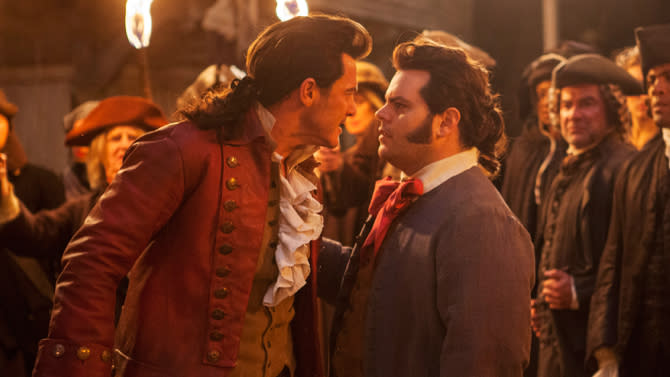All About That 'Gay Moment' in 'Beauty and the Beast': We Answer Your Burning Questions

For the past few days, the Internet has been exploding over the news that Beauty and the Beast (in theaters March 17) has what director Bill Condon called Disney’s first “exclusively gay moment.” In the remake of the 1991 animated film, the character of LeFou (Josh Gad), aide-de-camp to the villain Gaston (Luke Evans), appears to be in love with his captain. Thanks to a second, new character, LeFou’s storyline resolves in a moment of self-acceptance. But Condon has since said that his quote was “overblown,” and indeed, once audiences see the film, they’ll likely decide that the so-called controversy is just a tempest in a (talking) teacup. Here’s the rundown of what happens in the film, and why the reaction has been mixed even among gay Disney fans.
Warning: Beauty and the Beast spoilers to follow.
What exactly is the “gay moment” in Beauty and the Beast?
There are three parts to it. First, there are hints throughout the film that LeFou has a crush on Gaston, though no one ever says this outright. Second, there’s a moment that takes place in the castle toward the end of the film, when Gaston leads a mob of villagers to kill the Beast and the household objects fight back. Madame de Garderobe, the living wardrobe voiced by Audra McDonald, “defeats” a trio of villagers by giving them lightning-quick makeovers; suddenly clad in wigs and dresses, two of the men flee in embarrassment, while the third beams at Madame de Garderobe and sashays away. Finally, there’s the payoff moment: During a last celebratory dance at the castle, LeFou (now reformed) finds himself in the arms of the made-over villager (whose character name, according to IMDb, is Stanley). They dance. And that’s it.
That’s it? No kissing?
Nope, barely even touching. Just dancing, for about two seconds.
But LeFou is gay, right?
Yes and no. Condon has said that LeFou is gay, and Disney is standing behind him. Looking strictly at the content of the film, LeFou’s sexuality is never stated outright. Josh Gad’s performance offers plenty of hints for those paying attention, but we also see him flirt with women and talk about how potential wives find him “too clingy.” LeFou’s coming-out story is so brief and subtextual that many young viewers likely won’t notice it.
Then why is the director saying it’s Disney’s first “exclusively gay moment”?
Maybe what Condon was trying to say is that LeFou’s boy-meets-boy moment is the closest Disney has ever come to showing a gay love story, without making it into a joke. Remember, even Disney’s closest same-sex friends — The Lion King’s meerkat and warthog Timon and Pumbaa, Cinderella’s pet mice Gus Gus and Jaq — recoil when they accidentally kiss or embrace. Toy Story 3 has a cringeworthy running gag about the Ken doll’s effeminate nature, while making it clear that he’s hot for Barbie. Beyond that, most of the Disney characters who exhibit stereotypically gay characteristics — Aladdin’s Jafar, The Little Mermaid’s drag queen-inspired Ursula, Governor Ratcliffe in Pocahontas — have been villains. (Read more about that here and here.)
Watch the “Gaston” scene:
Hey wait, LeFou is a villain too!
In the 1991 animated film he’s a villain, if an idiotic one. The 2017 film takes pains to show that he’s not so much a bad guy as a man under the spell of the charismatic Gaston. The more evil Gaston gets, the more LeFou rebels, until finally — in a departure from the original film — LeFou turns on Gaston and takes Belle’s side. So by the time he has his “gay moment,” he has redeemed himself. That doesn’t change the fact that he’s a villain’s sidekick for most of the story — which is one reason that some fans are disappointed by the choice of LeFou as Disney’s pioneering gay character.
What more do LGBTQ fans want?
LeFou is not exactly an aspirational figure for the LGBTQ community. Gay Disney fans have been longing for an inspiring protagonist to call their own, not least of all because it would help gay and questioning young people — who have very high suicide rates — feel less alone. Last year a fan campaign with the hashtag #GiveElsaAGirlfriend urged Disney to give the Frozen princess a female partner in the sequel.
I’m confused. Is Beauty and the Beast’s gay subplot a good or bad thing?
It’s a small step in the right direction. If the press (and some easily frightened movie-theater owners in Alabama) hadn’t blown Condon’s quote into a huge story, LeFou’s love connection might have been seen as a delightful, subversive little Easter egg. As is, it’s bound to inspire a “That’s it?!” among both LGBTQ viewers and apprehensive conservatives alike. But maybe it will pave the way for more positive representation of diverse sexualities in future Disney films. At least there’s something there that wasn’t there before.
Read more:


